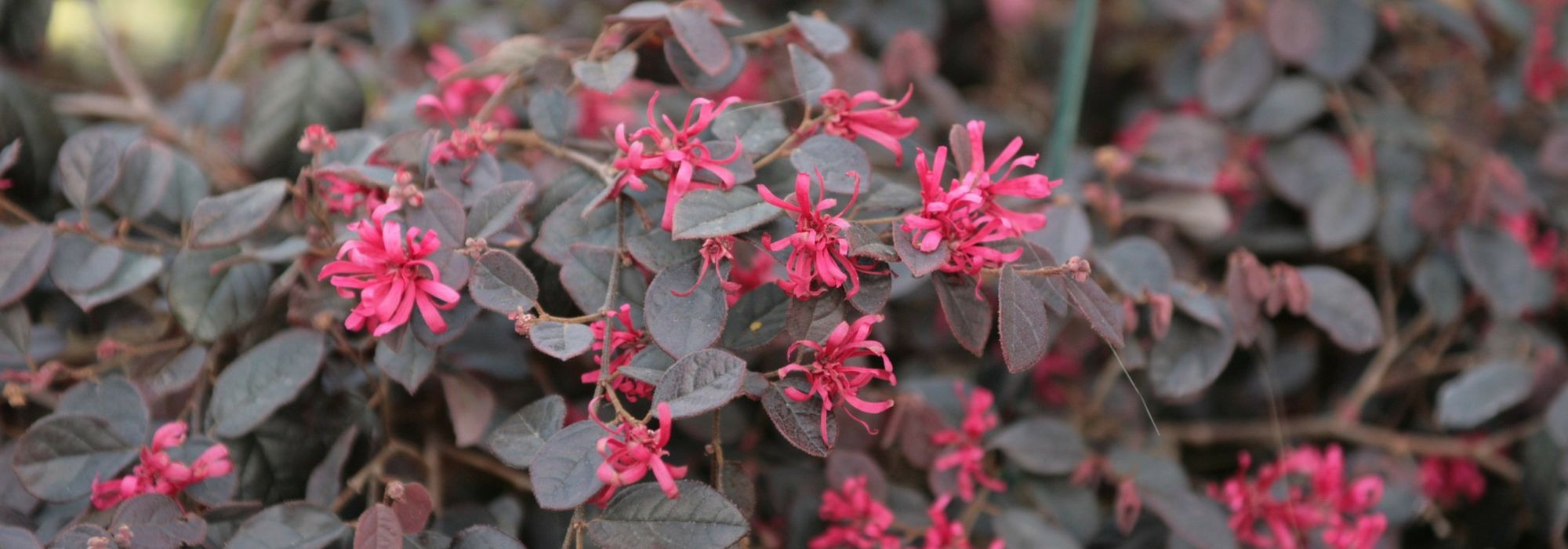
Loropetalum: planting, pruning and care
Contents
Loropetalum in a nutshell
- Loropetalum are small evergreen shrubs with spring flowering in purplish-pink or white.
- Flowers with crinkled petals adorn foliage for three weeks in March–April.
- Frost-tender shrubs should be grown in mild regions; elsewhere grow them in pots.
- Branches bearing small ovate dark green or purple leaves remain decorative all year round.
- Excellent plants for sheltered small urban gardens, perfectly suited to growing in pots.
A word from our expert
Loropetalum or loropetals are evergreen shrubs known to gardeners for the Loropetalum chinense Fire Dance, the Chinese loropetalum with purple foliage and bright pink flowers, more striking than the form that flowers pure white on dark green foliage.
These shrubs produce beautiful flowering with petals cut into fine ribbons, lightly scented, in late winter or early spring. This flowering sometimes repeats in late summer or autumn, depending on variety and climate. The most sought-after varieties carry purple foliage, sometimes very dark as in Loropetalum chinense ‘Pipa’s Red’, a true setting off for the red-pink flowers. Not only highly ornamental, loropetals are also easy shrubs requiring little maintenance, fitting the trend for small urban gardens and planted balconies. Give them gentle sun or partial shade in warm climate and well-drained, fertile soil. Moderately hardy (from -5°C to -10°C depending on variety), Loropetalum require a sheltered position; in cold regions they are grown in pots and overwintered in a bright room such as an entrance hall or a cool conservatory. While they prefer cool, slightly acidic soil, they are relatively tolerant, allowing them to be adopted in many mild regions.
These multifunctional shrubs create stunning displays alongside trees such as Japanese maples, other bushes or perennials. The purple foliage of Loropetalums makes an excellent backdrop for small spring bulbs, for the fawn culms of grasses and for the bronze-green of evergreen ferns such as Dryopteris erythrosora.
Description and botany
Botanical data
- Latin name Loropetalum chinense
- Family Hamamelidaceae
- Common name Loropetal, Chinese witch hazel
- Flowering between February and May with occasional repeat flowering in summer
- Height between 0.30 and 2 m
- Exposure sun or partial shade
- Soil type fresh and slightly acidic
- Hardiness moderate (-10°C)
Loropetalum form a small genus, close to Hamamelis, limited to one to three species of which mainly the species chinense is cultivated. These bushes of the family Hamamelidaceae occur in the Himalaya, China and Japan. The species chinense populates forests and copses of China, regions of northern and eastern India (Assam) and a small area east of Osaka (Ise). It grows up to 1,200 m altitude on rocky hills, and in open, dry woods. Rather tender, it requires long, warm summers so that wood is well ripened to withstand frosts down to -10°C.
Loropetalum have a dense, fairly spreading habit that can reach 2 m in every direction, with long, supple branches. Over time they can grow further – some century-old specimens never pruned approach 10 m high! But there are compact cultivars such as ‘Ruby Runner’ that hardly exceed 35 cm in height by 60 cm in diameter and are ideal as groundcover at the front of a border or to occupy a pot at the foot of an upright shrub or even a hanging basket.
Foliage with a thick lamina and short petiole consists of small entire, ovate and pointed leaves, 2–5 cm long, arranged alternately in a single plane along the fine horizontal shoots. Foliage remains evergreen in milder climates. Leaves are sometimes red on emergence before turning mid-green as days lengthen. Some cultivars such as ‘Red Tip’ remain purple throughout the year.
Unlike Hamamelis, flowering is little or not scented, emitting slight honeyed notes while being melliferous and nectariferous. It can start in February and finish in April depending on cultivar and severity of climate, lasting about three weeks. A repeat flowering may be observed during summer if shoots are not pruned at end of flowering. Flowers can cover entire foliage and provide a truly spectacular effect when bush is well established and growing in good conditions. Equipped with four long ribbon-like petals, slightly twisted, 1–2 cm long, they are grouped in tight corymbs of 3–6 giving the appearance of small pom-poms in leaf axils. Cultivars with pink, red or purplish flowers are particularly attractive as they harmonise with purplish tones of the foliage. Fruits are villous brown ovoid capsules about 8 mm in diameter containing two seeds.
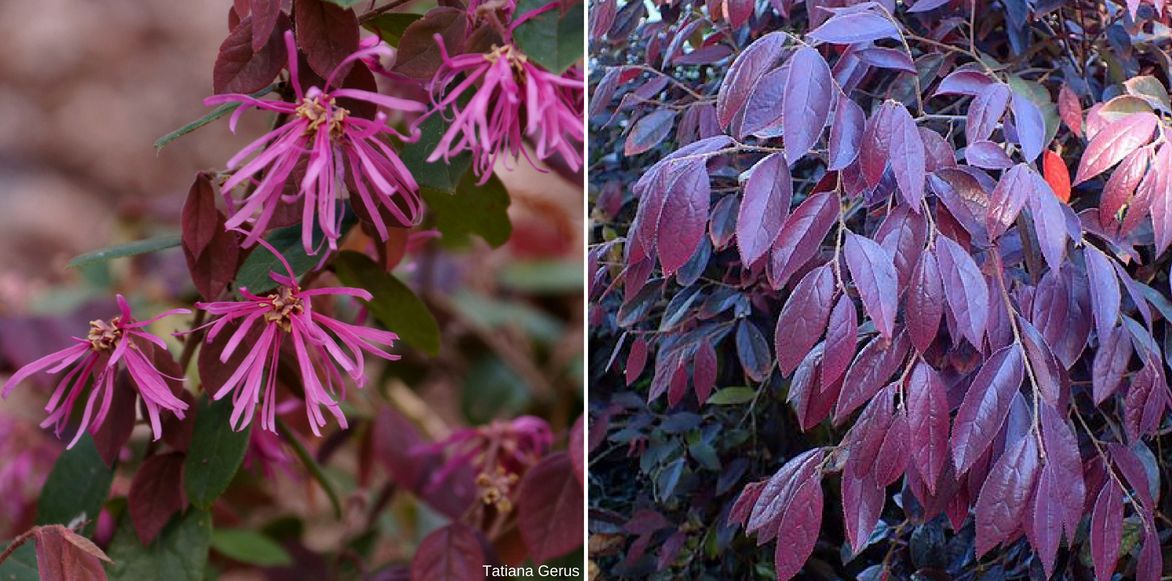
Striking atypical flowers and young purple foliage of Loropetalum chinense ‘Pipa’s Red’.
Main varieties of Loropetalum
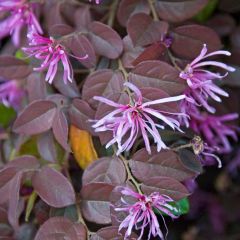
Loropetalum chinense var. rubrum Pipas Red - Chinese Witch Hazel
- Flowering time April to October
- Height at maturity 1,50 m

Loropetalum chinense var. rubrum Ever Red - Chinese Witch Hazel
- Flowering time April to June
- Height at maturity 80 cm
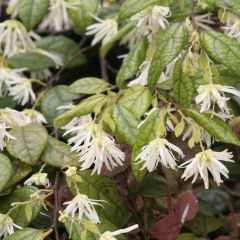
Loropetalum chinense
- Flowering time March to May
- Height at maturity 2 m
Discover other Loropetalum
View all →Available in 2 sizes
Available in 1 sizes
Available in 1 sizes
Available in 1 sizes
Available in 1 sizes
Available in 1 sizes
Available in 1 sizes
Available in 2 sizes
Available in 2 sizes
Available in 1 sizes
Planting
Where to plant loropetalum?
Loropetalum chinense is best planted in partial shade in fertile, well-drained soil, free of lime. Hardy down to -10°C, it suits mild climates and cool summers but beware, young plants can suffer from -5/-6°C, so they should be protected from severe frosts in northern France. You can install it in colder zones (down to -10°C), trained against a sheltered wall.
Although fairly tolerant of heat and drought once established, it nevertheless prefers partial shade, non-calcareous soils… and mild climates! In southern areas, opt for an aspect shaded in the afternoon or under the shade of a leafy tree, whereas full sun suits it well in a cool climate.
When to plant?
Plant loropetalums preferably in spring if winters are severe and in autumn otherwise, to ensure deep rooting before facing summer drought.
How to plant?
To plant a loropetalum :
- Soak the rootball in a bucket of water to thoroughly moisten it.
- Dig a planting hole, 50 cm in all directions or a trench if planting a hedge.
- Add a 10 cm drainage layer (gravel, sand…) if your soil is clayey.
- Add well-rotted manure or compost if soil is sandy.
- Place the plant in the planting hole.
- Replace the soil and press down lightly.
- Water.
- Spread a layer of mulch at the base to help keep good coolness around the roots. This will also limit weed growth.
Establishment is easy and rapid and only requires monitoring of watering during the first 2 years after planting.

Loropetalum chinense ‘Ever Red’ is well suited to growing in a pot.
Care and pruning
Loropetalum are very undemanding and require little maintenance.
Water regularly for first two years, especially during hot, dry spells. Unlike many bushes, pruning for flowering is not necessary.
Prune if necessary to reduce size of bush, after flowering. Use a shear, avoiding cutting back into old wood.
Possible pests and diseases
Few diseases or pests attack Loropétalum. Foliage sometimes shows chlorosis when soil contains too much lime. Add leaf mould or blonde turf to lower pH. Beware waterlogged soils which can encourage root rot and lead to death of bush. Bush sometimes develops tumours encircling shoots caused by olive knot (Pseudomonas savastanoï), incurable. Thoroughly disinfect your pruning shear.
Propagation: propagate Loropetalum
Loropetalum is easily propagated by cuttings in late summer (around August/September) from tips of August-ripened shoots.
Propagation by cuttings
Prepare a deep pot by filling it with potting compost mixed with sand, or take cuttings directly in open ground if soil is light, after loosening it with a garden fork and moistening it.
- Take a lignified stem 15 to 20 cm long from tip of current year’s shoot.
- Remove leaves at base of cutting.
- Insert cuttings to two-thirds of their length, ensuring they do not touch.
- Gently firm soil all around to remove air pockets and ensure good contact between potting compost and cuttings.
- Place them in shade under a sheltered cold frame.
- Wait until end of following spring to plant cuttings out.
Uses and companion plants
Loropetalum can be used as a specimen plant with their bushy, spreading and evergreen or semi-evergreen habit, tinted light green or purple. Flexible, horizontal shoots bearing small leaves give a very elegant aspect, especially as the generous spidery flowering remains very delicate. They stand out in spring displays, beautifully coloured while the garden is still largely unflowering.
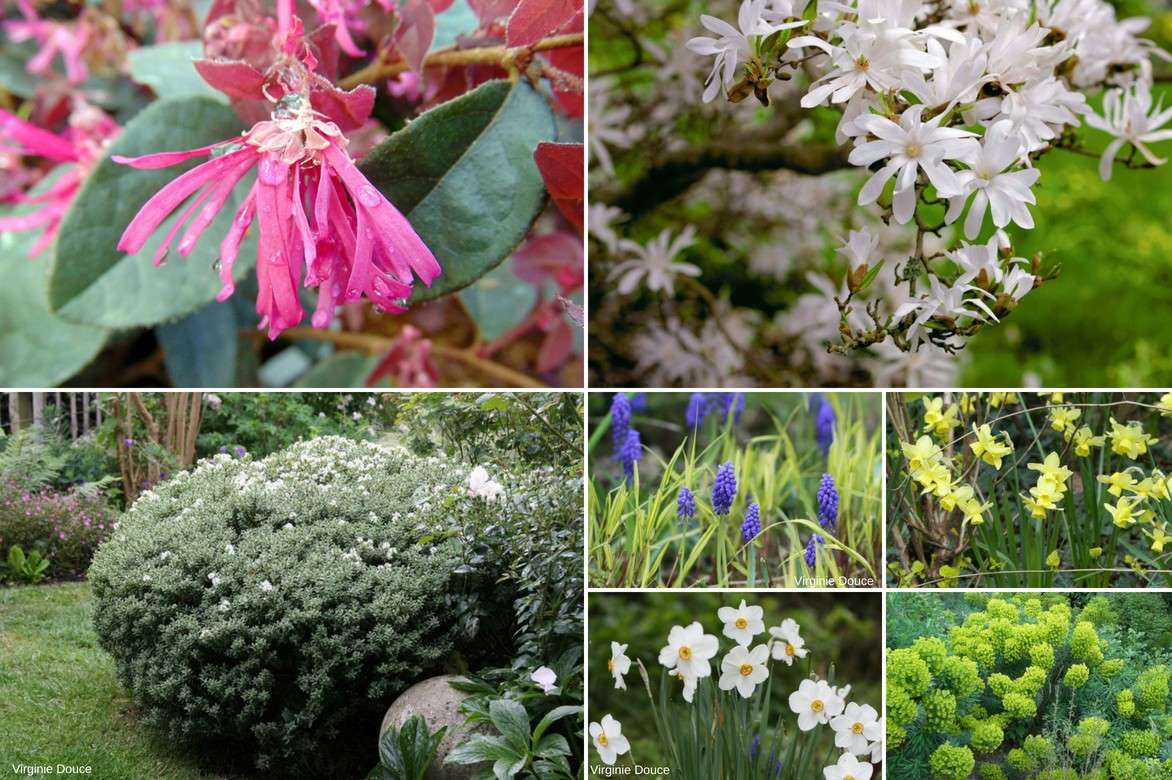
A spring pairing idea: Loropetalum chinense ‘Fire Dance’, Magnolia stellata, Muscaris armeniacum, Narcisse poeticus ‘Actaea’, Narcisse ‘Stint’, Euphorbia characias ssp. wulfenii and a few silvery balls of Hebe pinguifolia ‘Pagei’.
These bushes have become very fashionable on terraces or balconies of urban gardens but also in English-style gardens for their originality and possible combinations with perennials such as oriental hellebores or spring bulbs (snowdrops, muscaris, crocus, fritillaries…). They are well suited to growing in pots and take up little space. Their trailing habit also suits planting at height above a low wall.
They can also be used in an informal hedge to attract pollinators, or within a bed of heather-soil bushes with staggered flowering: camellias, shrub heathers, witch-hazel, azaleas and rhododendrons, andromedas and Hydrangea, for example. They can also be grown as bonsai. Like deciduous azaleas, with which it forms stunning combinations, Loropetalum chinense proves fairly water-wise once well established. In neutral soil and mild climates, it will accompany flowering of China roses (‘Old Blush’) from February.
Did you know?
The name Loropetalum comes from the Latin loro, meaning ‘strap’, and petalum, ‘petal’, referring to the arachnoid appearance of the corolla.
To go further
Discover our range of Loropetalum
- Subscribe!
- Contents
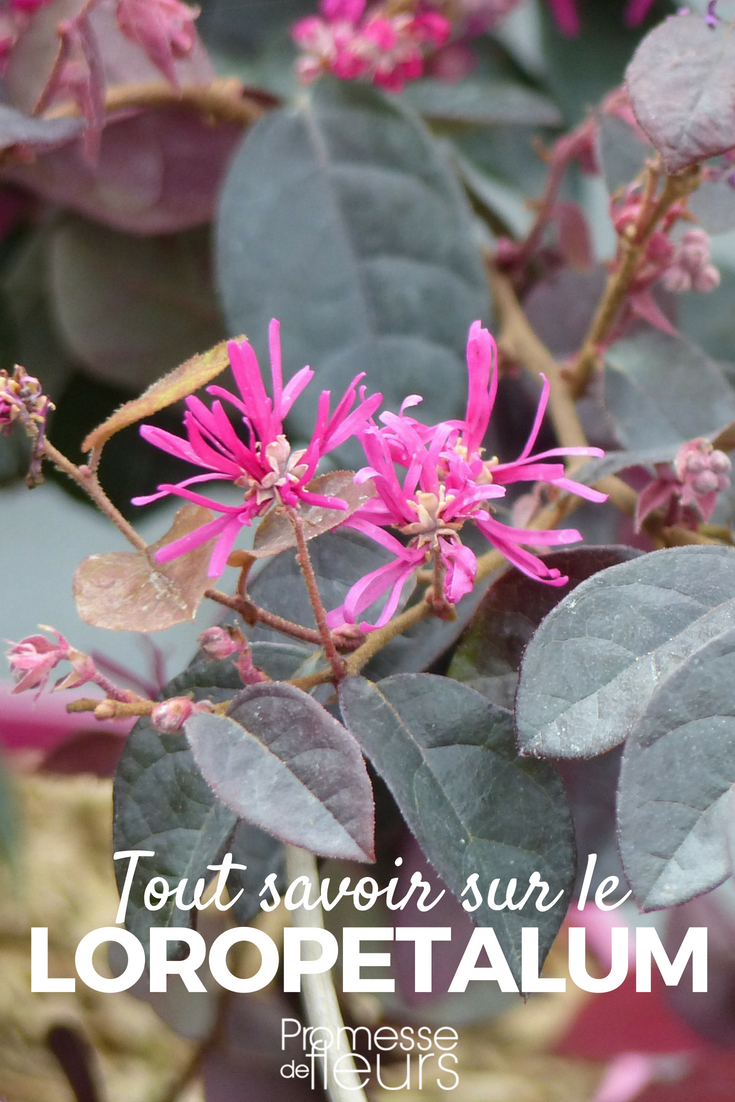
































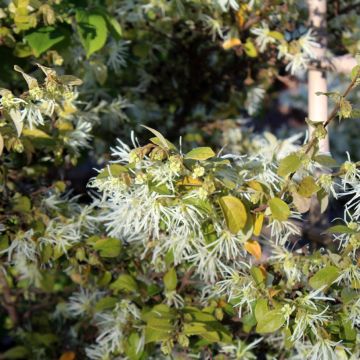
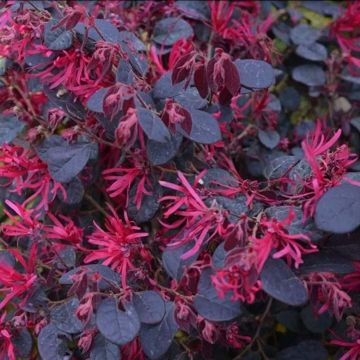
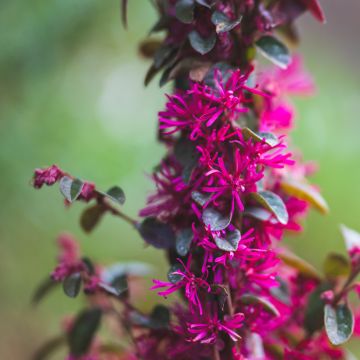
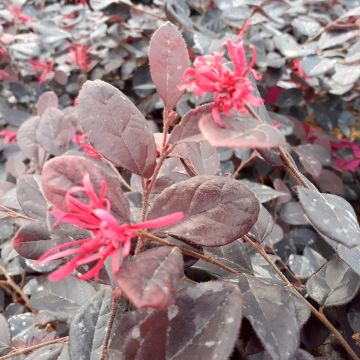
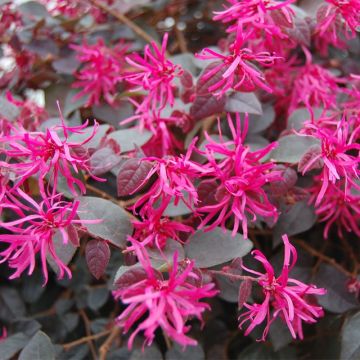


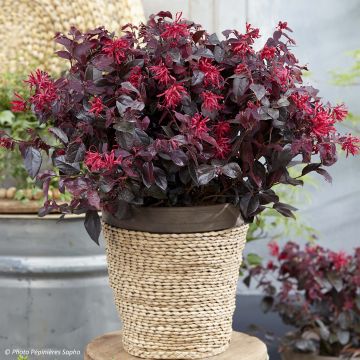
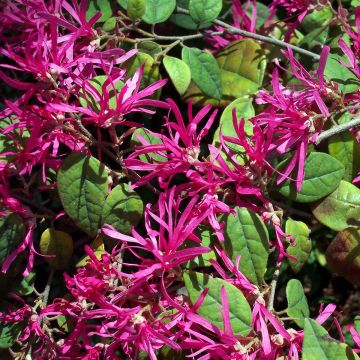
Comments